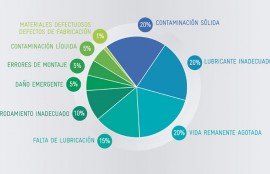Predictive maintenance is a strategy which increases the reliability of machines, allowing their true status to be identified as well as that of the lubricant which is in use.
The analysis of oil in gas engines is one of the most effective techniques for finding out the status of the engine and the viscosity, the basicity index, the acidity index and the i-pH are four key parameters in an analytical programme for gas engines of this type.
Viscosity
The viscosity is the most important physico-chemical parameter of any industrial oil. Variations concerning new oil are always of notable significance.
The increase in viscosity of a gas engine oil is associated with oxidation, nitration, contamination and extended periods of change.
A decline is fundamentally attributed to the loss of additives which improve the viscosity index.
Basicity index (TBN)
The basicity index is a measurement of the oil’s alkaline reserve. It is an indicator of the level of detergent and dispersant additives, as well as the capacity for neutralising the acidic compounds which form during combustion.
Depending on the type of gas in use, the oil will have a different alkaline reserve (BN). If it is natural gas, the oil used will have a low ash content, a BN of between 3 and 7. If it is a landfill gas, the BN could be more than 10 mgr KOH/gr sample.
Acidity index (AN)
The acidity index (AN) measures the quantity of the oil’s acidic compounds. High levels of AN usually indicate nitration, oxidation and contamination.
The following rule is typically applied: when the value of the used oil is double the value of the new oil, the oil has reached the end of its useful life.
There is another rule which is commonly applied: when the ascending value of the AN and descending value of the BN cross.

Figure. Automatic valuator of the acidity measurement (AN)
i-pH
The i-pH value is the measurement of the acid components dissociated with the potential of corrosiveness with metals.
This analysis detects small quantities of strong acids, therefore corrosive, which are present in the oil even if the total content of acid compounds (AN) has not yet increased significantly.
It can be used to indicate the relative changes which occur in the oil under oxidation conditions or by the contamination of combustible or exhaust gases.
Lubrication Management recommends a series of programmes for the analysis of oils in order to keep the gas engines in the best working conditions






